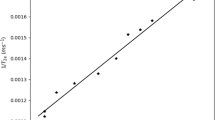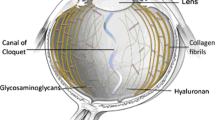Abstract
We have studied the nuclear magnetic resonance (NMR) relaxation behavior, and thus the dynamic properties, of the sodium ion in the vitreous body at different temperatures. The23Na NMR spectrum exhibits a resonance, the intensity of which accounts for an ion visibility of 100%. The23Na longitudinal and transverse relaxation times, at all temperatures but the highest, present two components, suggesting that the sodium ions are present in two states of different mobility, whose populations are in slow exchange on the NMR time scale. The correlation times and quadrupole coupling constants for the two sodium pools have been derived. The faster relaxation of a fraction of the vitreal sodium has tentatively been ascribed to the influence of the macromolecular framework of the vitreous body. The reported information may be of use for the understanding of the diagnostic applications of23Na magnetic resonance imaging of the ocular structures.
Similar content being viewed by others
References
Buist RJ, Deslauriers R, Saunders JK, Main wood GW (1991)23Na and flame photometric studies of the NMR visibility of sodium in rat muscle. Can J Physiol Pharmacol69: 1663–1669.
Civan MM, Shporer M (1978) NMR of sodium-23 and potassium-39 in biological systems. In Berliner LJ, Reuben J, eds.Biological Magnetic Resonance, New York: Plenum Press; 1–32.
Gupta RK, Gupta P, Moore RD (1984) NMR studies of intracellular metal ions in intact cells and tissues.Ann Rev Biophys Bioeng 13: 221–246.
Lai A, Saba G, Casu M, Dessi MA (1992) Analysis of sodium-23 nuclear magnetic resonance spin-lattice relaxation for the study of the intracellular sodium state.Biophys Chem 42: 73–77.
Lyon RC, Pekar J, Moonen CTW, McLaughlin AC (1991) Double-quantum surface-coil NMR studies of sodium and potassium in rat brain.Magn Reson Med 18: 80–92.
Pettegrew JW, Woessner DE, Minshew NJ, Glonek T (1984) Sodium-23 NMR analysis of human whole blood, erythrocytes, and plasma. Chemical shift, spin relaxation, and intracellular sodium concentration studies.J Magn Reson 57: 185–196.
Shinar H, Navon G (1984) NMR relaxation studies of intracellular Na+ in red blood cells.Biophys Chem 20: 275–283.
Shinar H, Navon G (1986) Sodium-23 NMR relaxation times in body fluids.Magn Reson Med 3: 927–934.
Fossarello M, Orzalesi N, Corongiu FP,et al. (1985)23Na NMR investigation of human lenses from patients with cataracts.FEBS Lett 184: 245–248.
Garner WH, Hilal SK, Lee S-W, Spector A (1986) Sodium-23 magnetic resonance imaging of the eye and lens.Proc Natl Acad Sci USA 83: 1901–1905.
Kohler SJ, Kolodny NH, D'Amico DJ,et al. (1989) Magnetic resonance Imaging determination of23Na visibility and T*2 in the vitreous body.J Magn Reson 82: 505–517.
Pettegrew JW, Glonek T, Minshew NJ, Woessner DE (1985) Sodium-23 NMR of intact bovine lens and vitreous humour.J Magn Reson 63: 439–444.
Stevens A, Paschalis P, Schleich T (1992) Sodium-23 and potassium-39 nuclear magnetic relaxation in eye lens. Examples of quadrupole ion magnetic relaxation in a crowded protein environment.Biophys J 61: 1061–1075.
Duncan G (1974) In Davson H, Graham LT, Jr., eds.The Eye, vol. 5, pp. 357–398, London: Academic Press.
Harding JJ, Crabbe MJC (1984) In Davson H, ed.The Eye, vol. IB, 3rd ed., pp. 207–492, London: Academic Press.
Martin ML, Delpuech J, Martin GJ (1980)Practical NMR Spectroscopy, London: Heyden & Son Ltd; 244–290.
Fletcher R (1972) Report AERE R6799. London: Her Majesty's Stationery Office.
Press WM, Flannery BF, Teulosky SA, Wetterling WT (1988) Numerical Recipes in C. Cambridge: Cambridge University Press.
Shaw D (1976)Fourier Transform NMR Spectroscopy, Amsterdam: Elsevier; 297–344.
Oser BL (1965)Hawk's Physiological Chemistry, New York: McGraw-Hill Book Co.
Nordman J (1968)Biologie et chirurgie du corps vitre, Paris: Masson; 37–51.
Urry DW, Trapane TL, Venkatachalam CM, McMichens RB (1989) Ion interactions at membranous polypeptide sites using nuclear magnetic resonance: determining rate and binding constants and site locations.Methods Enzymol 171: 286–342.
Monoi H (1985) Nuclear magnetic resonance of23Na ions interacting with the gramicidin channel.Biophys J 48: 643–662.
Gullans SR, Avison MJ, Ogino T,et al. (1985) NMR measurement of intracellular sodium in the rabbit proximal tubule. Am J Physiol249: F160-F168.
Hubbard PS (1970) Nonexponential nuclear magnetic relaxation by quadrupole interactions.J Chem Phys 53: 985–987.
Rooney WD, Barbara TM, Springer CS, Jr. (1988) Two-dimensional double-quantum NMR spectroscopy of iso-lated spin 3/2 systems:23Na examples.J Am Chem Soc 110: 674–681.
Forsen S, Drakenberg T, Wennerström H (1987) NMR studies of ion binding in biological systems.Q Rev Biophys 19: 83–114.
Bull TE (1972) Nuclear magnetic relaxation of spin-3/2 nuclei involved in chemical exchange.J Magnet Reson 8: 344–353.
Engström S, Jönsson B, Impey RW (1984) Molecular dynamic simulation of quadrupole relaxation of atomic ions in aqueous solution.J Chem Phys 80: 5481–5486.
Shellock FG (1992) Thermal responses in human subjects exposed to magnetic resonance imaging. In Magin RL, Liburdy RP, Persson B, eds. Biological Effects and Safety Aspects of Nuclear Magnetic Resonance Imaging and Spectroscopy.Ann NYAcad Sci 649: 260–272.
Marciani L (1993) Ph.D. Thesis in Physics, University of Genova.
Boada FE, Christensen JD, Huang-Hellinger FR,et al. (1994) Quantitative in vivo tissue sodium concentration maps: the effects of biexponential relaxation. Magn Reson Med32: 219–223.
Grandjean J, Laszlo P (1991) Microdynamics of exchangeable lithium and sodium ions in laponite gels.J Magnet Reson 92: 404–408.
Boicelli CA, Marciani L, Baldassarri AM, Cammarata G (1994) Proton and sodium MRI of ocular tumours. Radiology 193(P): 350.
Marciani L, Baldassarri AM, Mertel L,et al. (1995) Secondary hemangiosarcoma in canine eye. Proton and sodium MRI with histological correlation.Prog Vet Comp Ophthalmol 5: 13–18.
Author information
Authors and Affiliations
Rights and permissions
About this article
Cite this article
Boicelli, C.A., Giuliani, A.M. Sodium ion distribution in the vitreous body. MAGMA 4, 241–245 (1996). https://doi.org/10.1007/BF01772012
Received:
Accepted:
Issue Date:
DOI: https://doi.org/10.1007/BF01772012




